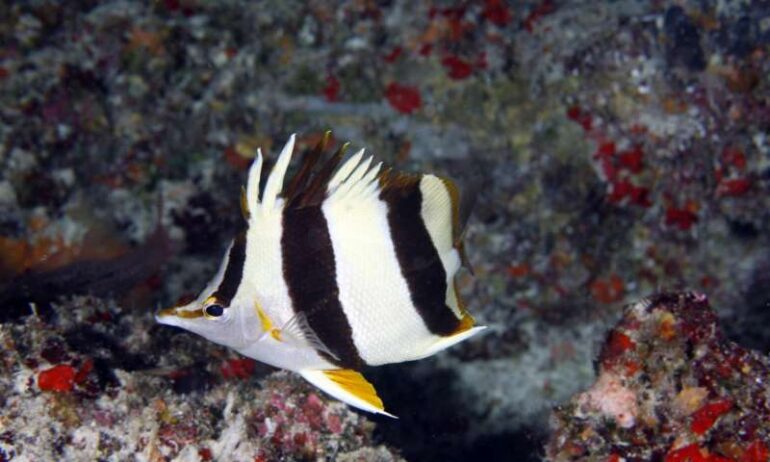Although known to exist for over 20 years and even referenced quite a few times here at Reef Builders, a new species of deep-water butterflyfish from the mesophotic reefs of the Papahanaumokuakea Marine National Monument was finally described today by researchers from NOAA and the Bishop Museum. The researchers used specimens collected in 2009 and again in 2015 for the paper.
This fish was named Prognathodes basabei after Pete Basabe, a veteran and experienced local diver from Kona who has helped with the collection of fishes for many scientific studies and educational displays. Basabe was key in supporting the dives that produced the first specimen of this new fish, that was formally described today in the scientific journal ZooKeys.
“Butterflyfish are the glamour fish of the coral reefs,” said Richard Pyle, Bishop Museum scientist and lead author on the publication. “They are colorful, beautiful, and have been very well-studied worldwide. Finding a new species of butterflyfish is a rare event.”
According to a post on Phsy.org, the species was observed over 20 years ago on a video camera on a manned submarine, but since This species was first observed in video taken from manned submersibles more than 20 years ago, at depths as great as 600 feet. At the time, Pyle and University of Hawaii marine biologist E.H. “Deetsie” Chave recognized this as a potential new species. However, scuba technology didn’t exist to allow a closer look.
It was often referred to as orangemargin or orange margin butterflyfish, and was listed on John E. Randall’s “Reef and shore fishes of the Hawaiian Islands” book in 2007. But it wasn’t until today that the formal description and official name would be released.
Collected on reef in the mesophotic “twilight zone,” typically on depths of 150 to 500 feet, these ecosystems are proving to be a new frontier of reef exploration. In the past, they were too deep for most scuba divers to explore and were shallower than most of the submarine-based exploration, but recent technological advances, such as electronic closed-circuit rebreathers, scientists are able to collect and preserve specimens like these.
“Discoveries such as this underscore how poorly explored and how little we know about our deep coral reefs,” said Randall Kosaki, NOAA scientist and co-author of the study. “Virtually every deep dive we do takes place on a reef that no human being has ever seen.”
Besides the specimens collected for this description, researchers have encountered this new butterfly fish frequently on deep-water dives up to 330, according to the article. In fact, live specimens of the new butterflyfish were collected on a NOAA expedition to Papahanaumokuakea in June of this year and are on display at Bishop Museum in Honolulu and at the Mokup?papa Discovery Center in Hilo. An additional specimen is on display in the Deep Reef exhibit at the Waikiki Aquarium.
[via Phsy.org]



